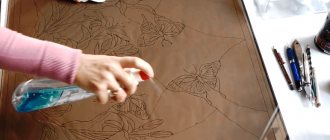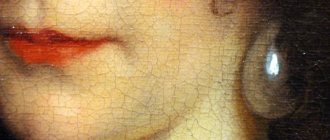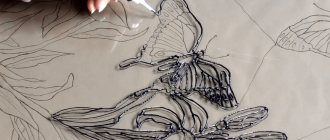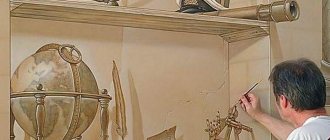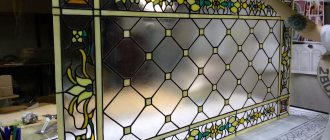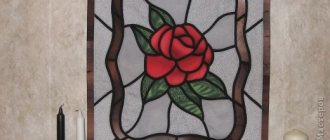Getting started - preparing the palette, brushes and paints
To properly prepare your workplace and choose work clothes, you need to know the features of acrylic. When dry, it becomes water resistant. If the drops get on your shirt or on a wooden table, it will be impossible to clean them.
Therefore, before starting work, you should put on an apron, wrap the table with cling film and cover the floor with thick paper. If acrylic does get on clothes or furniture during work, try to quickly wash the stain with water or fill it with solvent.
For work you will need the following materials:
- base: paper, cardboard, plywood or canvas;
- set of acrylic paints;
- thin and thick brushes;
- palette;
- glass of water.
For beginners, it is better to take thick paper with a rough texture or white cardboard as a basis: it is easier to draw on them. Having mastered the basics of acrylic technique, you can move on to canvas, wood and other materials.
If the painting surface is a little dark, prime it before starting work. Art and construction stores sell special white acrylic primer. Apply it evenly to the surface with a wide brush and let it dry completely before painting.
Acrylic paints are sold in individual tubes and in sets. For beginners, a set of 12 colors is suitable. It’s worth buying an additional jar or tube of white acrylic: this is the most popular color, it runs out earlier than others.
For specific surfaces (fabric, wood, glass, plastic), it is worth choosing the appropriate set: the type of paint should be indicated on the box. Any paints are suitable for drawing on paper and white cardboard.
For those who are just learning to paint, it is recommended to choose brushes made from squirrel fur as a material, although brushes made from fox fur are more common on sale. Palettes for acrylic paints are sold in art stores. Most often it is a white plastic board with a hole for your fingers.
This palette is easily washed off from paint that has not had time to dry. Sometimes palettes are made of plexiglass: they are in no way inferior to plastic ones, but are heavier in weight.
You can make your own palette from scrap materials (even from a disposable plastic plate).
Before starting work, put a little paint from each jar on the palette. To make it convenient to mix colors, artists place white paint in the upper left corner, warm shades (yellow, orange, red, brown) along the upper border of the palette, cool colors (green, blue, purple) along the left border. It is better to lay out black paint after blue or purple.
Artistic brushes differ in size, shape (round or flat), composition (synthetic or natural), and hardness (bristles and synthetics are stiffer than ponies and squirrels). Since acrylic paints are dense and heavy, medium-hard synthetic brushes hold them better.
Beginner artists should stock up on 3-4 brushes of different sizes. A wide flat brush is convenient for painting the background. Use a wide round brush to make textured strokes.
Medium brushes are useful for painting most objects, while thin brushes are useful for drawing details. High-quality round brushes, even large ones, have a thin, elegant tip.
It allows the artist to change the thickness of the line and move from broad strokes to drawing small details without changing the tool.
Brushes should be rinsed in clean water. Pour water into 2 cups so that one can wash off most of the paint, and the other can be used to completely rinse the brushes. Renew the water regularly as it becomes dirty. Place a clean, dry cloth next to the cups to blot your brushes and remove excess moisture.
To ensure that the brushes last longer and the bristles do not deteriorate, you can purchase a brush washer in which each brush is secured in such a way that it is in the water but does not touch the bottom with the bristles.
What can you paint with acrylic paints?
Acrylic is suitable for any idea. You can paint landscapes, still lifes or portraits from nature or copy from photographs. An art set with a palette of natural shades is suitable for conveying the beauty of nature and people as naturalistically as possible.
For fantastic scenes, it is better to additionally take a special set of decorative acrylic paints. They have specific properties (for example, a fluorescent glow or metallic luster) and are suitable for drawing details and bright accents.
With acrylic you can apply a decorative pattern to fabric or glass, paint wooden furniture or decorate plastic items. The dried drawing adheres to any surface quite reliably. An art store employee will tell you how to select materials for any design idea: from decorating leather shoes to decorating Christmas tree balls.
But from frequent contact with hands or other surfaces, the drawing will sooner or later be erased. Therefore, acrylic should not be used for painting silicone smartphone cases or cutlery: the paint will quickly crack or wear off.
Basic principles of acrylic painting
Acrylic painting can be airy and transparent - like watercolor, dense and bright - like gouache, voluminous and rich - like oil. Beginners should first make a sketch in pencil, and then cover the drawing with paint. The easiest way is to take a wide brush or palette knife and fill in the background with broad strokes, and then add small details.
To see the pencil sketch, you can add more water to the palette and create a light, translucent watercolor background, and then gradually paint over it. The more water you add, the lighter and more transparent your brushstrokes will be.
Brushes should be washed frequently and thoroughly. When acrylic dries, it becomes viscous, resulting in rough brush strokes. Do not leave dirty brushes: they will dry out unnoticed and become hopelessly damaged.
Use a spray bottle of water to keep your palette moist to keep your paints from drying out longer. But under no circumstances splash water on the paper: it will get wet and go in “waves.”
Leave the finished drawing on the table until completely dry. Carefully put the remaining clean paint that was not used during the painting process back into the jars. And if you need to take a short break during your painting session, simply cover your palette with cellophane or cling film.
How to prepare the basis for a future painting
Before choosing acrylic paint, take care to prepare the base. You can draw on wooden boards or plywood. You can use a stretcher or regular canvas. The easiest way to paint with acrylic is on paper, so a beginner should first master this canvas.
Choose paper with a dense, rough surface. For you to be able to paint with acrylic properly, the base must be strong. If you choose textured paper, glue a wood backing onto it.
Remove any air bubbles that have formed using a book - the canvas is ready for painting. Canvas for painting with acrylic can be additionally sanded, since the material adheres best to a smooth surface. Beginning painters often wonder whether it is necessary to prime the canvas for acrylic?
If you are working on boards, you will need an acrylic primer, which is sold in art stores. It is a special emulsion with titanium dioxide, which gives whiteness. The primer is applied to the prepared board in several layers and dried for 24 hours.
Secrets of painting with acrylic paints detailed description
Drawing pictures with acrylic paints has become a very popular hobby. After all, learning to depict the outside world on canvas with such material is no more difficult than with watercolors.
Therefore, if you want to get new, fresh emotions from painting, we suggest using this article. After all, in it you can find out basic information and some tricks that will be useful to every beginning artist!
We select materials and tools
In painting, you should be careful about the use and storage of your tools and materials. However, if you are new to painting, then you need to purchase some important items from this list.
The main material in acrylic painting is the paint itself. With a wide range of shades and saturations to choose from, a novice artist can easily become overwhelmed. Therefore, it is better to take a small set with primary colors for the first steps.
Without a brush, an artist will not be able to paint a single picture. Therefore, after painting, we move on to purchasing an important tool. Round brushes are considered universal in painting. Whether your instrument will have synthetic or natural bristles depends on you personally. Try and experiment! Or maybe a palette knife is just right for you.
As a basis for painting with acrylic paints, you can use cardboard, canvas, wood, etc. You can do your first works on a thick sheet of paper to feel the properties of the paint.
You also cannot do without a jar of water where you can clean the brush bristles or dilute the paint color. A tool like a palette will help you create complex colors. The most economical and simple solution would be a plastic disposable plate.
Step by step painting with acrylic paints
First of all, check your paints. Browse all jars and tubes. If acrylic paint for painting in a container has dried out, you can save it! Transfer some of the acrylic to the palette and try to restore it with thinner.
If the paint has completely dried, and the work urgently needs to be completed in the appropriate scale, then break the paint into small pieces with a sharp object. Next, heat it up with a hairdryer.
We “save” the resulting mass of thinners. Of course, such paint will not have its original properties. Therefore, it is better to immediately take care of your art materials: apply only part of the paint to the palette, immediately close the jar tightly with a lid, and store it from direct sunlight.
Then you certainly won’t have to think about how to dilute acrylic paint for painting. Prepare a base that is suitable for acrylic. It can be either canvas, thick paper or wood. Immediately moisten the palette with water using a spray bottle, and also do this from time to time throughout the painting process.
If you don’t know what to draw, then find acrylic painting lessons on the Internet and try to depict what is in front of you. Acrylic paints themselves are opaque. Therefore, dilute them with water, adjusting the degree of transparency. After all, the higher the percentage of water in the paint, the more transparent the acrylic will be.
This way, you can even achieve the effect of watercolor or airbrush on your canvas. First, paint large areas of the design with large brushes. Then gradually move on to small ones. Also, beginners should know that acrylic should be spread only with the edge of the brush, and to create clear contours, you can use adhesive tape.
If you need to lighten or darken an area of the drawing, then white and black acrylic tones will come to your aid. From time to time, look at your masterpiece through a mirror to correct the proportions or color schemes in the painting.
Secrets of painting with acrylic paints for beginners:
- When painting with acrylic, you should be aware that strokes dry very quickly. For many artists, this property of the material has become a great advantage, but for others it has become a disadvantage. If so, use a drying retardant for acrylic.
- As acrylic dries, it becomes darker.
- The paint can be applied in a paste form. For this, many people use special thickeners.
- You can also paint with acrylic in a very liquid state, when the paint is diluted with water.
- When dry, acrylic does not form cracks.
- Acrylic forms an even film after applying strokes. It can only be washed off with special solvents after the paint has completely dried. It shines and does not require additional fixatives.
- You can paint with acrylic paints on any non-greasy base: canvas, linen, wood, glass and metal.
- To remove some fragments of the drawing, fresh paint can be easily washed off with water, but if it has dried, then you cannot do without special solvents!
- The final version of the painting can have the effect of a watercolor or oil image.
- Using acrylic you can create three-dimensional convex paintings.
A little patience, diligence and effort in painting with acrylic - and you yourself will not notice how you have already mastered this painting technique, and the paintings look like real masterpieces.
Source: https://decorys.ru/sekrety-risovaniya-akrilovymi-kraskami.html
Tips for artists
Painting with acrylic on paper or wood is a creative process that is a lot of fun. To make it even more enjoyable, follow these guidelines:
- Paints darken significantly when dry. Take this into account when choosing shades for the future canvas. Choose non-toxic materials for work, even if they cost more. Wear an apron while working to avoid getting your clothes dirty.
- In addition to professional brushes with long handles, paints and canvas base, stock up on decoupage glue, as well as a convenient spray bottle filled with water.
- It is better to use a plastic palette - it is practical and easy to clean. Don't forget to use clean water to rinse your brushes.
Having mastered the technique of painting with acrylic, you will be able to create real masterpieces. A little patience, diligence and the right materials for the job are the key to impressive results.
Master class on painting with acrylic paints for beginners
We offer to sign up for a master class on painting with acrylic paints for beginners. Acrylic painting is gaining wide popularity. Acrylic painting is much easier to master than watercolor or oil painting. Acrylic paintings have a special, unique charm.
Art took on a different reality when acrylic appeared. Unusual synthetic paints quickly became popular. Acrylic is used by artists, designers, and manicurists. Women's nails are painted with acrylic, interior decoration is done, and paintings are painted. Why is polymer material attractive?
Mixed bristle brushes
This is a universal painting tool that combines the advantages of natural and artificial brushes. These brushes are great for a variety of acrylic paints, including those that contain latex.
Combination brushes are characterized by good paint absorption and excellent paint transfer to the surface being painted. When used correctly, they retain their shape excellently. This tool has proven itself especially well when working with impregnations, varnishes and stains.
Interesting Acrylic Painting Techniques
Do you have acrylic paint, canvas or paper ready to go and you really want to paint? So, the fun begins! But how exactly do you get started?
Here's a guide to acrylic painting techniques for beginners, including brush strokes, color mixing, and more, so you'll be painting like a pro in no time.
The beauty of acrylic painting is that it can look completely different depending on how you apply it.
Dry brush
When you apply paint to a canvas with a dry brush, you create a vibrant, strong stroke of color. The lines will be jagged and choppy (since there is no water to soften the edges), but this can give you a focused painterly effect.
Blur
If you add enough water, acrylic becomes like watercolor! Thinned paint can be used to apply translucent washes to surfaces. But unlike watercolors, acrylic paint will be permanent and indelible. By experimenting with the amount of water you can achieve a variety of textures.
Texture
Add a ton of tiny dots with a wide round brush to create shape or texture with subtle changes in shade.
splashing
There is no greater joy than this! Using a damp brush, you can pour or splatter paint onto your work surface for an uneven effect. This is fantastic for creating an abstract landscape or a starry night, or just to add texture.
How to apply paint?
Artistic painting with a sponge instead of a brush - why not? Using the corner of a sponge or even a paper towel, blot to create different pops of color. This creates a texture that cannot be achieved with any other applicator.
Palette knife
Applying paint with a palette knife is an instant way to enhance your work. And since it's no different than putting icing on a cake, even beginners and kids can do it easily. Plus it's also fast.
Detailing
If you want sharp, realistic detail, you'll need a small, thin brush to get everything in thoroughly.
Underpainting
Start drawing by sketching the image in paint or on a small piece of paper. Choose a color that contrasts
with the main palette of the finished work.
What brushes are suitable for acrylic?
To learn how to display different visual effects and paint objects using different techniques, we recommend purchasing a set of acrylic brushes:
- Round: used for drawing small details and lines.
- Flat: used for painting individual areas of the drawing and applying bold strokes.
- Fans: Indispensable for mixing acrylic paints and blurring boundaries.
- Flat shortened: suitable for preparing thick strokes.
- Flat beveled: used to secure corners and carefully draw small details.
Try to work with different brushes to perfect each technique and turn painting from a labor-intensive process into a pleasure.
Painting with acrylic paints - how to use and what you need for this
With the advent of acrylic paints, painting received new possibilities. Acrylic paints can be applied to almost any substrate, be it canvas, cardboard, wood, fabric, glass and many others.
The paints are diluted with water and dry quickly. After drying, they become water-resistant and weather-resistant, do not turn yellow or fade. Also, acrylic paints are absolutely hypoallergenic.
Many artists create wonderful works using acrylic paints. Among them there are both adherents of traditional painting and various modernists trying to achieve a new level of reality in painting.
For example, world-famous self-taught artist Justin Geoffrey paints incredible pictures using acrylic, using the volume of strokes to create sculptural relief. So, in acrylic painting you have room for creativity. But where to start?
We collect the necessary materials
The first thing you need to paint with acrylics is acrylic paints
